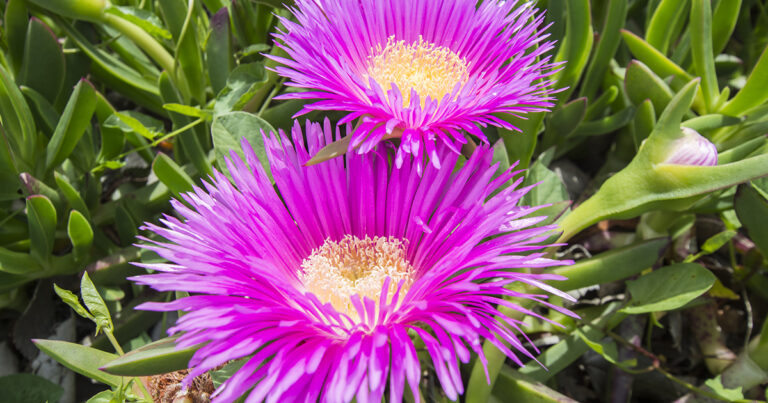Ice plants, also known as delospermas, are a popular low-growing ground cover that produces an abundance of daisy-like flowers. These succulent plants are native to South Africa but can now be found in many regions with a dry, warm climate.
Ice plants are easy to grow and care for, which makes them a popular choice for rock gardens, borders, and containers. They have attractive foliage that can range in color from green to blue-gray and even purple. Ice plants are drought-tolerant and can survive in poor soil conditions (similarly to the jelly bean plant), but they do require well-draining soil to avoid root rot.
Most common Ice plant varieties:
- Cooper’s ice plant (Delosperma cooperi)
- Starburst (Delosperma floribundum)
- Hardy yellow (Delosperma brunnthaleri)
Care
Ice plants come in different types, from ground covers to bushy subshrubs, and are ideal for sunny but sheltered desert gardens, rock gardens, slopes, or as ground cover or edging plants. Caring for them is not very hard, but there are a few things to keep in mind.
For successful growth, ensure your planting location gets a lot of sun and has fast-draining soil, and space the plants 15 to 18 inches apart. Finally, each spring, prune out any winter-killed stems.
- Soil: Ice plants need well-draining, dry soil and do not grow well in constantly moist or dense clay soil; sandy and gravelly soils are ideal, lots of nutrients are not necessary.
- Water: This plant needs little watering once it’s established, and one watering every two weeks is enough during the growing season. When the weather is very hot, weekly watering might be necessary.
- Light: Ice plants require a significant amount of full sunlight, because the lack of it can lead to weak growth and leggy plants. Provide at least six hours of direct sunlight/day to promote optimal growth.
- Temperature: Ice plants, including the “hardy” ones, are sensitive to cold temperatures, and it’s essential to check their hardiness range before growing them as perennials. The ideal temperature for them is between 50-75°F (10-24°C), winter mulching is recommended for snowy areas.
Propagation
Ice plants can propagate naturally through self-seeding (almost like tomatoes) and spreading stems. You can also propagate them through division, which is best done in the spring.
To divide a mature plant, dig it up while avoiding root damage, and divide it in half at the roots using a sharp spade. Replant each half in a suitable location at the same depth as the original plant, gently pat down the soil, and lightly moisten it.
Check out our full guide on how to grow your own Ice Plant!
Common Pests
Frequently Asked Questions
Ice plants are easy to grow and care for, which makes them a popular choice for beginner gardeners. Just ensure your planting location gets a lot of sun and has fast-draining soil, and space the plants 15 to 18 inches apart. Finally, each spring, prune out any winter-killed stems.
Why are my ice plants dying?
Ice plants can wither or die due to water issues, with wilting being an indication of a need for more water, but too much water can cause stem or root rot, leading to the plant’s death.
Do ice plants need full sun?
Ice plants just simply love sunlight. For successful growth, ensure at least 6 hours of direct sun every day.
Do ice plants do well in pots?
Yes, they like pots (just like Dahlias) but make sure that the pot has good drainage since Ice plants do not like sitting in water and can quickly get waterlogged.
Is Ice plant toxic to pets?
Fortunately, Ice plants are non-toxic to pets such as cats or dogs.

